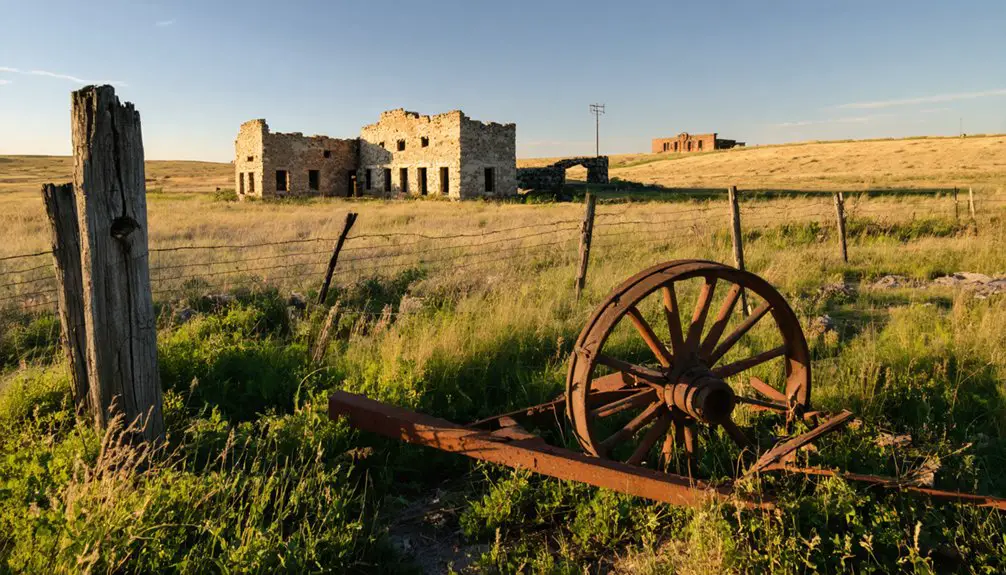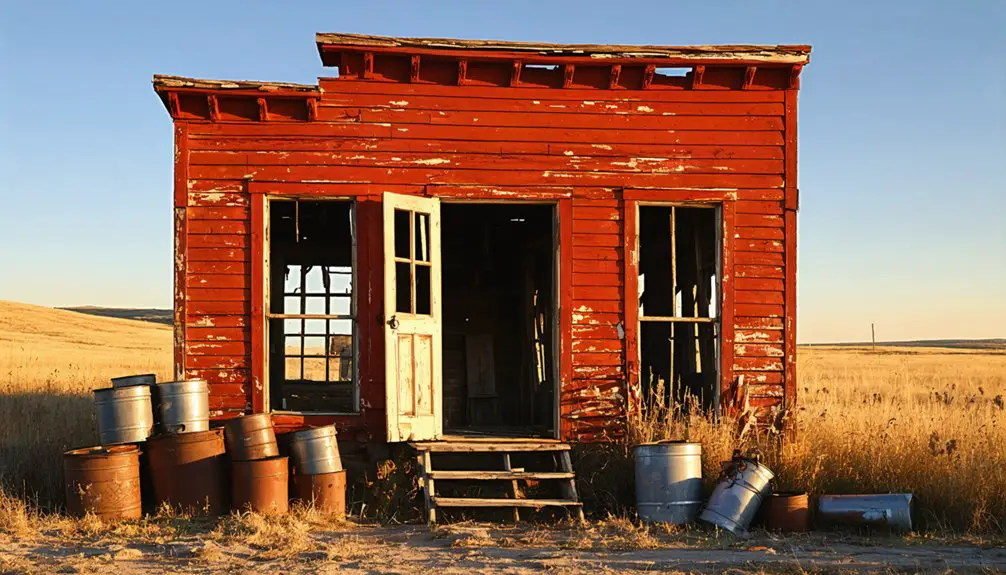You’ll find Eminence, Kansas’s haunting remains in the southwestern part of the state, where it briefly thrived as a frontier settlement in 1887. The town engaged in a legendary county seat battle with rival Ravanna that involved voter fraud, armed confrontations, and intervention by Bat Masterson. After the Kansas Supreme Court dissolved Garfield County in 1893, both communities collapsed. Today, only the vandalized hotel and cemetery hint at the dramatic frontier tale that unfolded here.
Key Takeaways
- Eminence was established in 1887 in southwestern Kansas and briefly served as Garfield County’s seat before the county dissolved in 1893.
- The town declined after losing a bitter county seat rivalry and subsequent legal battles, leading to its eventual abandonment.
- Physical remnants include the original hotel structure and Eminence Cemetery, making it a destination for ghost town enthusiasts.
- The community initially thrived on farming, ranching, and buffalo hunting before political disputes led to its downfall.
- Eminence’s story exemplifies the boom-and-bust cycle of frontier towns in the American West during the late 1800s.
The Birth of a Prairie Settlement
In the mid-1880s, the prairie settlement that would become Eminence took root in southwestern Kansas, initially as the Cuyler post office before relocating two miles east along the Pawnee River.
You’ll find its origins reflect typical settlement patterns of the era, as pioneers pushed westward into former Native American territories.
The town’s founding fathers, including C.J. Buffalo Jones and L.W. Fulton, secured a state grant through the Creola Town Company in 1886.
Though they’d originally planned to name it Creola, they settled on “Eminence” in 1887, a name suggested by Lyman Naugel.
The settlement’s location proved strategic for prairie agriculture and buffalo hunting, with access to water and emerging transportation routes.
Like the Osage territory near Independence, this area was once part of Native American lands that settlers gradually claimed for their own development.
As a candidate for the Garfield County seat, Eminence represented the ambitious spirit of frontier expansion.
The town achieved its greatest prominence when it was officially designated as the county seat in 1888.
Early Days and Community Growth
While settlers flocked to Eminence following its official establishment in June 1887, the town’s early community life centered around its strategic position along the Pawnee River.
You’d have found a determined group of pioneers building their lives under the leadership of notable figures like C.J. Buffalo Jones and L.W. Fulton, who helped shape the town’s foundation. Much like an éminence grise, these leaders worked quietly behind the scenes to establish the town’s governance structures.
The early infrastructure reflected the basic needs of frontier life. You would’ve seen a post office, which served as a crucial communication hub, and likely a schoolhouse where children gathered for education.
Frontier settlements grew around vital services, with post offices and schoolhouses forming the backbone of emerging community life.
Community cooperation became essential as residents faced typical prairie challenges, from harsh weather to transportation limitations. Despite the lack of railroad access, the townspeople pulled together, particularly during the heated county seat dispute with Ravanna, demonstrating the strong bonds that frontier life demanded.
County Seat Rivalry With Ravanna

You’ll find that Eminence’s fierce county seat battle with Ravanna came to a head in the 1887 election, where both towns’ vote totals suspiciously exceeded their populations and led to accusations of ballot stuffing.
The situation became so tense that famous lawman Bat Masterson and twenty armed deputies had to oversee the voting process to prevent violence from erupting between the rival communities.
After a lengthy legal challenge by Eminence alleging fraudulent votes cast by non-residents, the Kansas Supreme Court overturned Ravanna’s narrow victory and declared Eminence the rightful county seat in 1888.
The disputed election initially showed 467 votes for Ravanna against Eminence’s 432, though these results were later invalidated.
By 1892, both towns faced a devastating blow when the Kansas Supreme Court dissolved Garfield County, effectively ending their bitter rivalry.
Disputed Election Results
During the contentious battle for Garfield County’s seat in 1887, Ravanna initially claimed victory with 467 votes to Eminence’s 432 – a slim margin of 35 votes that would soon face intense scrutiny.
You’ll find that election integrity quickly became the central issue when Eminence challenged the results. Their investigation revealed shocking evidence of voter fraud, including ballots cast by deceased individuals.
The matter escalated to the Kansas Supreme Court, where voting rights and electoral fairness took center stage. After careful review, the court invalidated Ravanna’s victory, declaring Eminence the rightful county seat on December 11, 1888.
The State Adjutant General had to intervene to maintain order as Eminence officials seized the county records, marking a dramatic end to this frontier election dispute. Bat Masterson and deputies had been hired to keep peace during the original election.
Physical Confrontations Escalate
The election dispute soon gave way to physical confrontations between the rival towns.
You’ll find that armed confrontations became increasingly common, with Eminence supporters hiring legendary lawman Bat Masterson and twenty deputies to maintain peace during voting.
Election tensions reached such heights that both towns arrived at the polls heavily armed.
The conflict intensified when Ravanna refused to surrender county records.
Eminence residents responded with forcible nighttime raids on Ravanna’s courthouse, attempting to seize official documents and even the treasurer’s safe.
These raids ultimately led to the discovery of ballot box stuffing during the initial county seat election.
When Ravanna organized an armed force to reclaim the records in 1891, the situation became so volatile that Kansas State Militia intervention was necessary.
The Adjutant General’s arrival helped prevent bloodshed and forced both sides to await court decisions before taking further action.
Supreme Court Victory
After months of intense litigation spanning from winter 1887 to July 1889, Eminence secured a decisive victory when the Kansas Supreme Court ruled it the rightful county seat.
The judicial integrity of the process revealed Ravanna’s electoral fraud, with evidence showing 60 fraudulent votes from non-residents and deceased individuals had swung the original election by 35 votes. Just as in the case of Jack v. Kansas, the Supreme Court demonstrated its commitment to upholding the rule of law and exposing corruption.
You’d have witnessed quite a spectacle during the trial, as tensions ran so high that lawman Bat Masterson had to provide protection for witnesses.
Some witnesses faced threats, with one even disappearing after masked men visited his hotel.
When the state attorney general’s office deducted the fraudulent votes, Eminence celebrated by raising a 100-foot flagpole and hosting a gala day, though they’d still need to forcibly seize county records from defiant Ravanna officials.
Rise and Fall of Garfield County

If you’re tracing Eminence’s history, you’ll find its fate intertwined with Garfield County’s dramatic six-year existence from 1887 to 1893.
You’ll discover how the fierce county seat battle between Eminence and Ravanna consumed resources and attention, while legal challenges mounted over the county’s insufficient size of less than 432 square miles.
The Supreme Court’s ruling led to county seat removal, causing significant damage to government property as Ravanna citizens resisted the transfer of offices.
The county’s eventual dissolution by the Kansas Supreme Court stripped Eminence of its status and triggered its rapid decline, as government operations transferred to Finney County and residents abandoned their ambitious frontier town.
Much like the German and Czech settlers who would later populate Oklahoma’s Garfield County after the 1893 land opening, Eminence attracted pioneering families seeking new opportunities in the American West.
County Formation Politics
During Kansas’s rapid westward expansion in 1887, Garfield County emerged as a new political entity, carved primarily from unorganized Buffalo County territory with additional land from Finney and Hodgeman counties.
You’ll find that political instability marked its formation from the start, as diverse settler groups including Swedish families and Mennonite German Baptists vied for influence in the newly established county.
Despite meeting the required 600-resident threshold, governance challenges plagued the county’s legitimacy. At just 432 square miles, it fell short of Kansas’s minimum size requirement for counties.
This fundamental flaw, combined with fierce disputes over the county seat between Eminence and Ravanna, ultimately led to the Kansas Supreme Court declaring the county’s formation illegal in 1892, dissolving it entirely by 1893.
Battle for County Seat
The battle for Garfield County’s seat ignited immediate tensions between two ambitious frontier towns. When Eminence challenged Ravanna’s expected dominance, both communities demonstrated their willingness to sacrifice election integrity for power.
Each town, despite populations of only 300-400 people, somehow managed to report over 1,000 votes, leading to accusations of using dead men’s names and non-citizens to pad ballot boxes.
- You’d have witnessed lawman Bat Masterson arrive with 20 deputies to maintain order.
- You’d have seen the intensity of community division as masked men threatened witnesses.
- You’d have observed Eminence’s men forcibly seizing county records from Ravanna’s courthouse.
The bitter rivalry culminated in a two-year legal battle, with the Kansas Supreme Court ultimately favoring Eminence – though their victory would prove short-lived.
County Dissolution Impact
Following its disputed rise to county seat status, Eminence’s triumph proved devastatingly brief when surveyors discovered Garfield County failed to meet Kansas’s minimum size requirement of 432 square miles.
The Kansas Supreme Court ruled the county illegally organized, leading to its dissolution and annexation by Finney County in 1893.
The ruling triggered rapid economic decline throughout the region. You’ll find that Eminence and its rival Ravanna both suffered severe community disintegration as residents left to seek opportunities elsewhere.
The lack of government support and infrastructure made it increasingly difficult to maintain these once-promising towns. While schools in Ravanna continued operating into the mid-20th century, both communities eventually succumbed to abandonment.
Today, you’ll only discover scattered remnants of buildings and cemeteries marking their existence.
Life in a Frontier Town

Life in frontier Eminence reflected typical patterns of 1880s Kansas settlement, where residents primarily engaged in farming, ranching, and buffalo hunting to sustain themselves.
You’d find community resilience on display as settlers faced frontier challenges together, gathering at the post office and local businesses to share news and resources.
- You could trade goods at local shops, which served as social hubs where farmers and ranchers exchanged stories and supplies.
- You’d witness Buffalo Jones and other hunters returning with their quarry, contributing to the town’s economic diversity.
- You’d participate in communal events that strengthened social bonds, helping neighbors overcome the harsh realities of prairie life.
Despite the uncertain political climate, daily life centered around these shared experiences that defined the American frontier spirit.
Notable Pioneers and Leaders
Notable pioneers shaped Eminence‘s brief but significant frontier history, with C.J. Buffalo Jones and L.W. Fulton leading the way as co-founders of both Garden City and Eminence.
You’ll find Lyman Naugel’s influence in the town’s very name – he’s the one who suggested “Eminence” after the initial Creola designation.
The town attracted pioneering families who established roots in this frontier community, building homes and creating livelihoods from the ground up.
Local merchants and farmers formed the backbone of daily life, while regional leaders guided the town’s development through its formative years.
The Creola Town Company worked with influential figures to establish the framework for what they hoped would become a thriving county seat, though their dreams would ultimately remain unfulfilled.
The Path to Abandonment

While the pioneering spirit initially fueled Eminence’s growth, a series of setbacks in 1887 marked the beginning of the town’s decline.
The community dynamics shifted dramatically as Eminence and Ravanna’s fierce rivalry for the county seat drained both towns’ resources and morale.
A bitter county seat battle between rival towns Eminence and Ravanna ultimately exhausted their resources and crushed community spirit.
Key factors that led to Eminence’s abandonment:
- The disincorporation of Garfield County dealt a devastating blow to the town’s political significance.
- Economic factors, including agricultural challenges and isolation from major markets, made sustaining the community increasingly difficult.
- The closure of essential services, particularly the post office in 1942, signaled the final chapter of this once-promising settlement.
You can still find remnants of this ambitious frontier town that fell victim to political strife, environmental challenges, and changing economic realities.
Modern Legacy and Cultural Impact
Today, Eminence’s legacy persists through its physical remnants and cultural footprint in Kansas history. You’ll find the original hotel still standing, though vandalized, while the Eminence Cemetery serves as a solemn marker of the town’s past, commemorated by a stone sign erected in 1998.
The town’s cultural significance extends beyond its physical ruins. You’ll see Eminence featured in popular media, including the 1999 TV movie “Atomic Train,” while its ghost town narratives contribute to broader discussions of Western frontier life.
The site offers valuable lessons about boom-and-bust cycles and community dynamics that shaped the American West. Local historical societies and researchers continue to document Eminence’s story, preserving its place in Kansas heritage while attracting photographers and history enthusiasts to its haunting remains.
Frequently Asked Questions
What Did the Original Town Plat of Eminence Look Like?
Ever wonder about frontier dreams? You’d see a classic grid-style town layout with uniform blocks near the Pawnee River, featuring designated lots for homes, businesses, and a $10,000 courthouse reflecting its historical significance.
Were There Any Native American Settlements Near Eminence Before Its Founding?
While Native American tribes traveled through the region, you won’t find direct evidence of settlements at Eminence’s exact location. No historical artifacts specifically link permanent tribal villages to the town site.
What Crops Were Primarily Grown by Eminence Farmers?
Like waves of grain dancing in the wind, you’d find farmers practicing crop rotation between wheat and corn, with Turkey Red wheat becoming their primary crop after 1874’s agricultural revolution.
Did Any Famous Outlaws Ever Pass Through Eminence?
You won’t find any documented outlaw encounters or notorious figures in Eminence’s history. The town’s most dramatic stories centered on political disputes with neighboring Ravanna over county seat status.
What Was the Average Land Price in Eminence During Its Peak?
Ever wonder what frontier dreams cost? While exact records aren’t preserved, you’d likely have paid $1-5 per acre for farmland and considerably more for town lots during Eminence’s peak land value and historical economy.
References
- https://en.wikipedia.org/wiki/Eminence
- https://lostkansas.ccrsdigitalprojects.com/sites/lostkansas/files/private_static/2022-12/LT_FI_Eminence_Doll.pdf
- https://www.visitgck.com/eminence-and-ravanna-the-story-of-finney-countys-ghost-towns/
- https://fhsuguides.fhsu.edu/kansasheritage/finneycounty
- https://www.kspatriot.org/index.php/articles/56-kansas-local-history/550-lost-towns-of-finney-county.html
- https://shop.notgrass.com/slides/slide/on-the-prairie-77
- https://krex.k-state.edu/items/ef549fb5-3fbe-4e6b-95e5-f5aa0b38a2f4
- https://esirc.emporia.edu/bitstream/handle/123456789/1577/McQuin Vol 8 Num 3.pdf
- https://www.treasurenet.com/threads/eminence-and-ravanna.66339/
- https://legendsofkansas.com/garfield-county-kansas/



